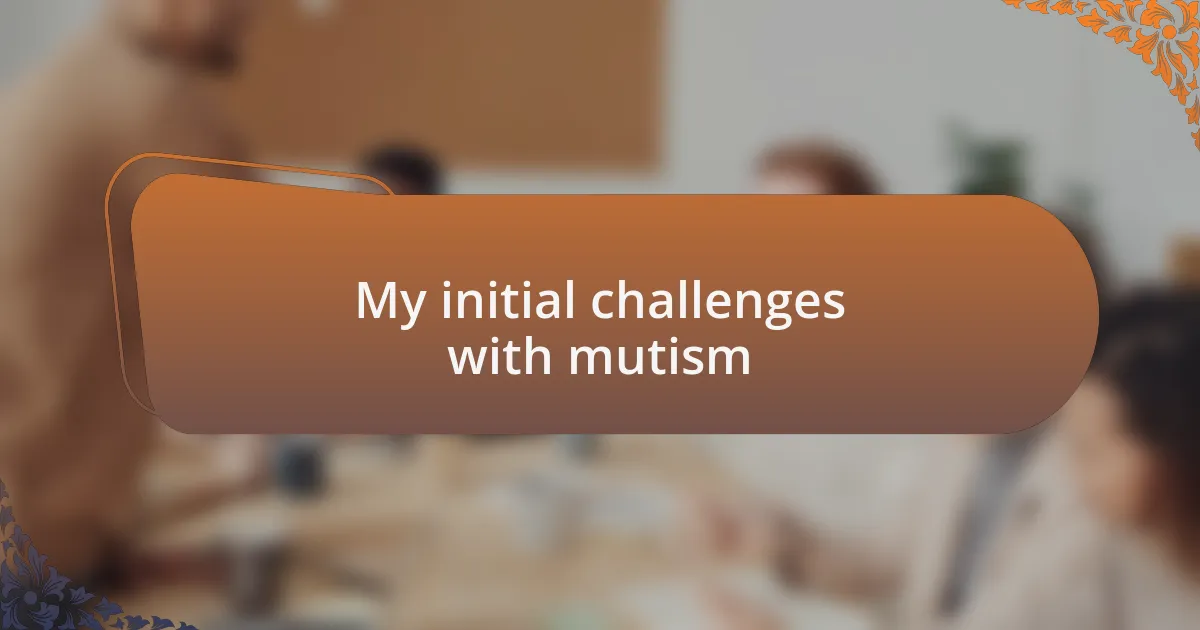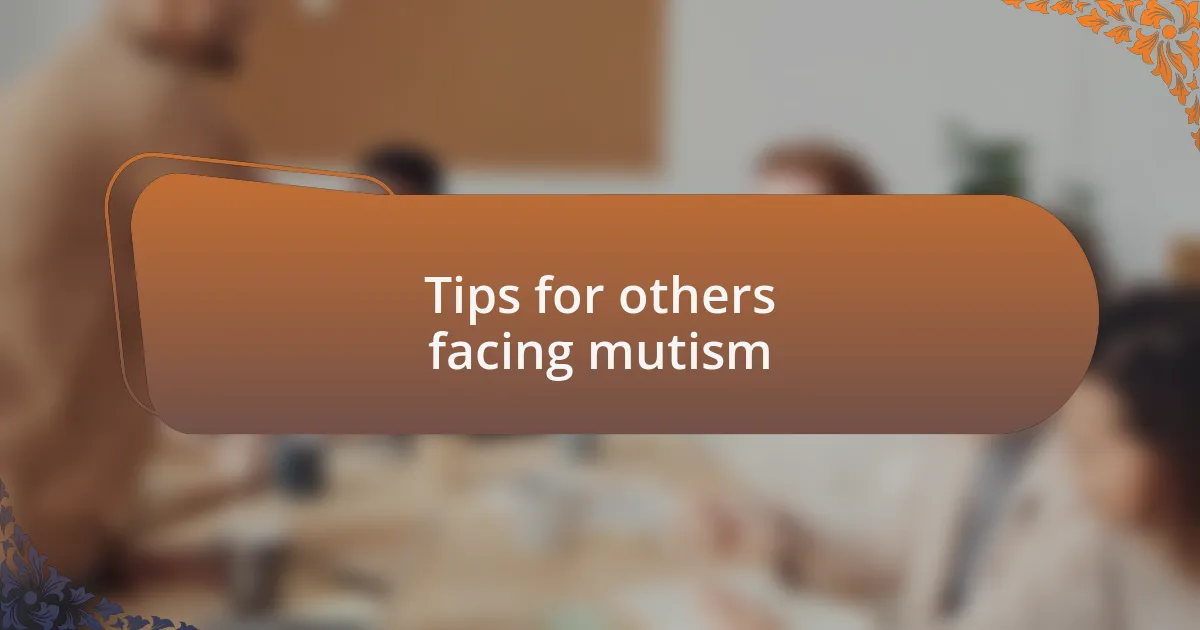Key takeaways:
- Selective mutism is a complex anxiety disorder where children can speak comfortably in some settings but struggle in others, often due to fear and anxiety.
- Gradual desensitization is an effective therapeutic approach that helps children face their anxiety through small, manageable speaking goals, fostering a supportive environment.
- Celebrating small victories and employing techniques such as deep breathing, role-play, and connecting with supportive peers can significantly enhance confidence and communication skills.
- Creating a safe space and allowing children to progress at their own pace is crucial in overcoming the challenges presented by selective mutism.

What is selective mutism
Selective mutism is a complex anxiety disorder most commonly seen in children, wherein they struggle to speak in specific social situations despite being able to communicate comfortably in others, like at home. I remember a time when a family member shared how her child would chatter away at the dinner table yet would fall silent at school, almost as if a switch had flipped. It’s puzzling and heartbreaking to witness someone’s ability to communicate being stifled by fear.
This condition often stems from extreme shyness or anxiety, and it can manifest in a variety of ways. For instance, the child may speak freely with trusted adults but become mute around peers or during structured activities. I felt a deep sense of empathy when I learned about a boy who could engage with his dog without hesitation, yet the thought of speaking in front of his classmates left him frozen. How can a simple interaction with others create such overwhelming fear?
Understanding selective mutism is crucial for both parents and educators, as it’s not just about refusing to talk; it’s an intense emotional struggle. I’ve seen firsthand how patience and support can make a difference, offering an environment where a child gradually feels safe to express themselves. It begs the question: how can we foster that sense of safety and understanding in our communities? By recognizing the signs and offering gentle encouragement, we can help these children find their voice in those challenging moments.

Understanding gradual desensitization
Gradual desensitization is a therapeutic approach that helps individuals, particularly children with selective mutism, confront and reduce their anxiety in social settings. I recall witnessing how a young girl, who initially struggled to voice her opinions in a small group, gradually built her confidence by exchanging simple greetings with classmates first. It’s fascinating to see how small steps can lead to significant changes over time, isn’t it?
The process involves slowly introducing the child to increasingly challenging speaking situations while providing supportive reassurance. I remember working with a timid boy who started off feeling terrified just to say “hi” to a peer. We set up small, manageable goals, like practicing in front of a trusted adult, and each little victory sparked more willingness to engage. How empowering it felt for him when he eventually spoke during a class discussion after weeks of practice!
By fostering a supportive environment, parents and educators can play a pivotal role in this journey. I often think about the importance of patience in this process; it’s not just about pushing for immediate results but celebrating each small step forward. How much progress can be made when we approach these moments with compassion and understanding? Gradual desensitization not only aids in overcoming mutism but also nurtures resilience, paving the way for a brighter future.

Importance of gradual exposure
Gradual exposure is essential because it allows individuals to build confidence at their own pace. I recall an instance where a child was terrified of speaking during story time but thrived after starting with just whispering to a stuffed animal. Each day, their bravery grew as they took tiny steps, reminding me that every small effort counts.
It’s crucial to remember that rushing the process can often reinforce anxiety rather than alleviate it. I once saw a parent who was eager to see immediate gains push their child too hard, resulting in setbacks. It reinforced my belief that allowing children to lead the way fosters a sense of control and ownership over their experiences.
The beauty of gradual exposure lies in its ability to transform dread into comfort over time. I’ve seen many children discover their voices, and it’s incredibly rewarding to witness that journey. What can be more fulfilling than watching someone blossom from silence to self-expression, one step at a time? Each milestone, no matter how small, deserves recognition and celebration.

My initial challenges with mutism
The initial challenges I faced with mutism were overwhelming. I remember sitting in class, wanting to join in on the conversations, yet feeling as though a heavy weight was pressing down on my chest. It was as if the words were trapped inside, and the silence became a barrier that separated me from my peers.
At times, my fear of speaking felt all-consuming, leaving me isolated during group activities. I vividly recall a day in gym class where the instructor asked for volunteers to lead a game. My heart raced, and despite wishing to step forward, I found myself rooted to the spot. The fear of judgment loomed large, and I questioned—what if I stumbled over my words or no one listened?
As I gradually learned to navigate these challenges, I began to recognize that my silence didn’t define me. I discovered moments where I could express myself through art or writing, which served as a bridge to communication. It made me wonder—could acceptance begin in the spaces where speech faltered?

Experiences with gradual desensitization
Gradual desensitization became a vital part of my journey in overcoming mutism. I recall the first time I practiced speaking in front of a mirror, a seemingly small act that felt monumental at the time. As I stumbled through my words, I had to remind myself—what if every misstep was just a stepping stone toward feeling comfortable expressing my thoughts?
I also remember my first group session at school, where the teacher encouraged us to share three things about ourselves. My palms were sweaty, and my stomach churned, yet I was determined to take that leap. With each person sharing, I felt a sense of camaraderie; it helped me realize I wasn’t alone in my fear. It left me wondering—could vulnerability be a gateway to connection?
There were still days when doubt crept in, like when I was asked to participate in a class discussion. I could feel my heart pounding, but I chose to breathe slowly and remind myself of the progress I had made. It was a slow climb, but each small victory bolstered my confidence. This experience made me reflect—how many of us find strength in sharing our stories, even when the journey is fraught with challenges?

Techniques that worked for me
One technique that truly transformed my experience was the use of role-play with a close friend. I remember crafting scenarios where I’d practice asking for help in a store or ordering food. It felt silly at first, but as I navigated these situations in a safe space, I began to see that communication didn’t have to feel so daunting. Has anyone else experienced a shift in confidence by simply pretending?
Another successful method for me was utilizing visuals, like index cards with phrases I wanted to practice. I’d write down everyday conversations I wanted to have, and the act of reading them aloud at home made a difference. I distinctly recall standing in my living room, clutching those cards, feeling the words resonate more each time I spoke them. Wouldn’t it be amazing if something as simple as a card could help unlock our voices?
Finally, sharing my progress in a journal helped me track my emotions and setbacks. Writing about my experiences allowed me to process my feelings without judgment. One entry detailed the overwhelming joy I felt when I spoke up during a family dinner; even the simplest triumphs felt monumental. How many victories go unacknowledged in our journeys? I learned that celebrating those moments can sometimes make all the difference.

Tips for others facing mutism
When facing mutism, it’s important to celebrate small victories. I remember the first time I spoke to a cashier without feeling my heart race. It was such a simple interaction, yet the exhilaration I felt afterward was immense. Have you ever noticed how a tiny step can lead to monumental shifts in your confidence?
Another tip that worked for me was to practice deep breathing before speaking. I still use this technique today; taking a few deep breaths calms my nerves and makes me feel more grounded. It’s astonishing how something so basic can act as a powerful tool to ease anxiety. When was the last time you paused to breathe before engaging in a challenging conversation?
Lastly, I found that connecting with others who understand your experience can be incredibly validating. I joined a support group where we shared our stories and tips. Hearing others express their struggles and triumphs made me feel less alone and helped me gain new perspectives. Have you considered reaching out to someone who shares your journey? You might be surprised by the comfort and strength that comes from finding community.